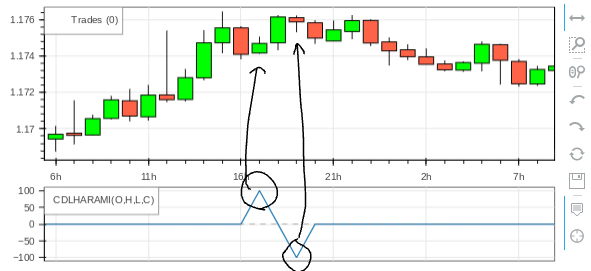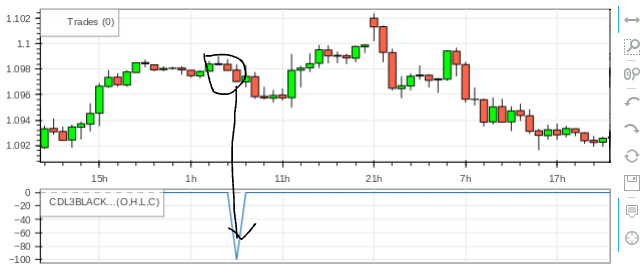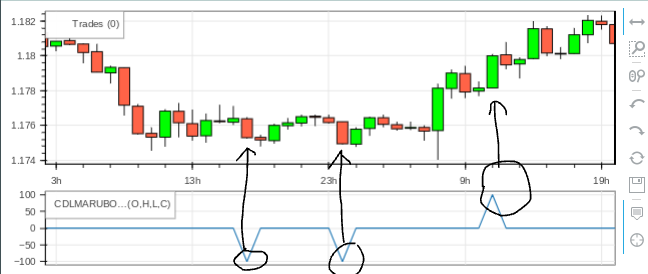PythonのTA-Libの使用方法をウェブで検索すると、移動平均やボリンジャーバンドなどのOverlap Studiesの関数の記事が目立ちますが、Pattern Recognitionというカテゴリーもあります。
Pattern Recognitionはローソク足の特別なパターンを検出する関数群で、はらみ足や三羽烏、数多くのパターンを見つけてくれます。
この記事にたくさんの関数の概要と使い方の紹介がありますが、私も過去の記事で説明した方法でユーロドルの値動きから、いくつかのパターンを見つけていきたいと思います。
はらみ線
まずははらみ線です。
基本的なコードは以下の通りで、以降はtalibの関数を色々変えていきたいと思います。
import talib
from backtesting.test import EURUSD
from backtesting import Strategy, Backtest
from bokeh.io import save
class MyStrategy(Strategy):
def init(self):
# 使いたい関数、関数の引数をインジケータ用のメソッドIの引数にする
self.I(
talib.CDLHARAMI,
self.data.Open,
self.data.High,
self.data.Low,
self.data.Close,
)
def next(self):
pass
def main():
bt = Backtest(EURUSD, MyStrategy)
bt.run()
# qiitaに載せやすいように調整
fig = bt.plot(plot_volume=False, superimpose=False)
fig.children[0].children[0][0].height = 200
save(fig, filename='CDLchart.html')
if __name__ == '__main__':
main()
出力したはらみ線のフラグつきのチャートを拡大したものです。パターンが検出されると、100または-100を返すようですね。
よく見ると、2番めのフラグは当日の高値が前日の終値を超えていて、ネット情報とは挙動が異なります。talibのソースを確認すると、やはり少し実装が異なるようです。
/* Proceed with the calculation for the requested range.
* Must have:
* - first candle: long white (black) real body
* - second candle: short real body totally engulfed by the first
* The meaning of "short" and "long" is specified with TA_SetCandleSettings
* outInteger is positive (1 to 100) when bullish or negative (-1 to -100) when bearish;
* the user should consider that a harami is significant when it appears in a downtrend if bullish or
* in an uptrend when bearish, while this function does not consider the trend
*/
outIdx = 0;
do
{
if( TA_REALBODY(i-1) > TA_CANDLEAVERAGE( BodyLong, BodyLongPeriodTotal, i-1 ) && // 1st: long
TA_REALBODY(i) <= TA_CANDLEAVERAGE( BodyShort, BodyShortPeriodTotal, i ) && // 2nd: short
max( inClose[i], inOpen[i] ) < max( inClose[i-1], inOpen[i-1] ) && // engulfed by 1st
min( inClose[i], inOpen[i] ) > min( inClose[i-1], inOpen[i-1] )
)
...
} while( i <= endIdx );
確認せずに使うと、期待と異なる挙動で戸惑うところでした。TA-Libの挙動が期待とは異なることがあると心に留めておきましょう。
三羽烏
次は三羽烏です。以下の部分の変更だけでOKです。
self.I(
talib.CDS3BLACKCROWS,
self.data.Open,
self.data.High,
self.data.Low,
self.data.Close,
)
/* Proceed with the calculation for the requested range.
* Must have:
* - three consecutive and declining black candlesticks
* - each candle must have no or very short lower shadow
* - each candle after the first must open within the prior candle's real body
* - the first candle's close should be under the prior white candle's high
* The meaning of "very short" is specified with TA_SetCandleSettings
* outInteger is negative (-1 to -100): three black crows is always bearish;
* the user should consider that 3 black crows is significant when it appears after a mature advance or at high levels,
* while this function does not consider it
*/
各ローソク足のシャドウ(下ひげ?)が短くないといけないようです。TA-Libのローソク足パターン認識は少しクセがあります。
丸坊主
次は丸坊主です。関数名もCDLMARUBOZUです。
talib.CDLMARUBOZU
こちらは狙い通りの挙動でした。
終わり
まだまだたくさんありますが、今回はこの辺で。
このようなローソク足パターンも、インアウトのタイミングとしては有用かもしれませんね。


